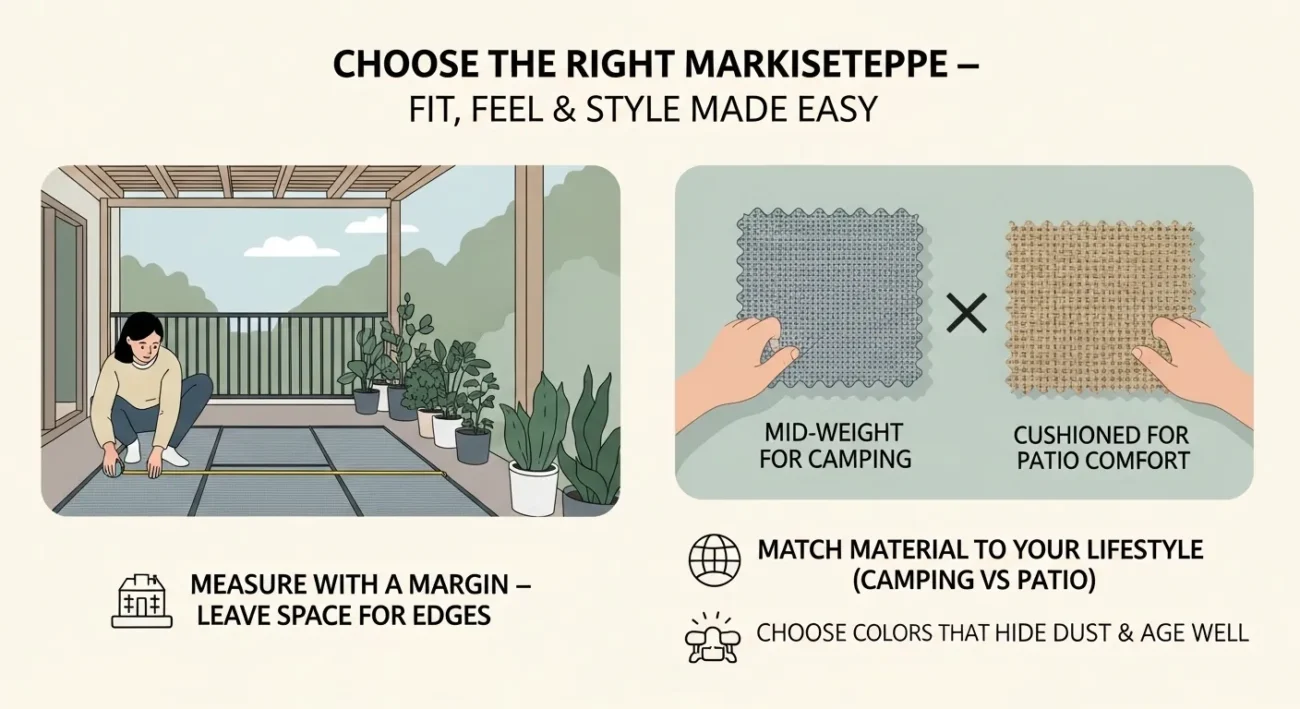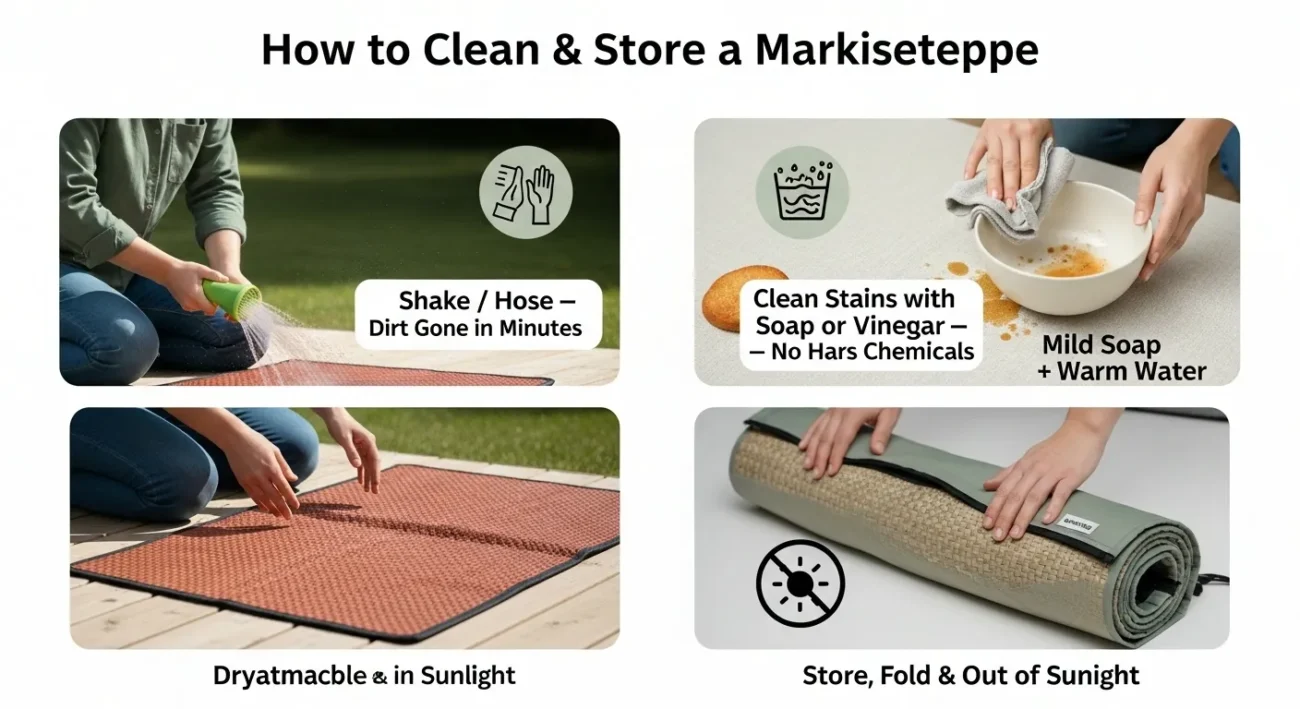
Home & Decor Blogs: DIY, Interior Design & Lifestyle Ideas
Markiseteppe: The Ultimate Guide to Stylish Outdoor Comfort

Markiseteppe sounds fancy, but it’s simple: it’s the outdoor mat or carpet you roll out under an awning to make life outside feel cozy, clean, and calm. In camping areas, on balconies, and across backyard patios, a good markiseteppe keeps feet happy, mud out and the vibe stylish. You’ll learn what to buy, how to size it, how to install it, how to care for it, and how to make it look like it was designed for your space.
Understand the Basics
What is “Markiseteppe”
The word joins the Norwegian “markise” (awning) and “teppe” (carpet), and in real life it means a resilient, weather friendly carpet for the ground under your awning, pergola, tent, or balcony setup. It’s not a fragile living room rug and it’s not just a tarp; it’s a comfortable surface that handles sun, light rain, dirt, and weekend traffic without fuss.
Why a Markiseteppe is Not Just an “Outdoor Rug”
Standard outdoor rugs focus on looks first. A markiseteppe balances looks with breathability, fast drying, and easy cleaning, so you can shake off sand, rinse off grass clipping stains, and get back to the fun. Well made options use woven polypropylene and let air pass through, which helps grass survive and keeps moisture from getting trapped.
Where People Actually Use It
Campers roll it out in the fortelt or under roll out awnings to stop grit at the door. Apartment dwellers put it on balconies to warm up cold concrete. Homeowners use it on patios or under pergolas for a softer, safer, barefoot friendly surface. Retailers in Scandinavia stock a wide range of sizes because it’s a standard part of outdoor living space.
Choose the Right Markiseteppe

How to size your space without guessing
Measure the full usable footprint under your awning or pergola. For camping, measure from the caravan wall to the awning’s front edge (the projection) and from left to right arm (the width). Subtract a small margin about a hand’s width on each side so edges don’t curl up against wall art or trip people. For balconies and patios, leave a narrow border to show the deck or tiles; it looks intentional and makes rinsing easier.
How to match material to your lifestyle
Most markisetepper use woven polypropylene for durability, breathability, and quick drying. If you camp often, pick a mid weight weave that packs down without becoming flimsy. If you host backyard dinners, choose a slightly denser weave that feels cushier underfoot. If you’re placing it on grass, prefer a breathable weave so the lawn doesn’t suffer. Breathable polypropylene weaves are common in trusted camping brands and are design trends to let air through.
How to decide on pattern and colors that age well
Solid, mid tone grays and muted stripes hide dust and pollen better than very light beiges or very dark charcoals. A small, repeating pattern adds visual interest without fighting your furniture. If your space is shaded, a lighter mat brightens it up; in full sun, a medium gray stays cooler to the touch than deep black.
Markiseteppe Size & Spec Cheat Sheet
Below is a simple table to match spaces to sizes and features. Treat it as a starting point always check your own measurements before buying.
| Space Type | Typical Size (m) | Approx. Weight Range | Best-For Material | Comfort Feel | Practical Notes |
|---|---|---|---|---|---|
| Small balcony | 1.2 × 2 to 1.5 × 2.5 | Light to mid | Woven polypropylene | Smooth, barefoot-friendly | Leaves a rinse border and avoids door rub |
| Caravan fortelt | 2.5 × 4 to 3 × 5 | Mid | Breathable polypropylene | Firm yet cushioned | Packs in a carry bag and resists wet grass. |
| Patio under pergola | 3 × 4 to 4 × 5 | Mid to dense | UV resistant PP | More cushioned | Keeps grit off paving and dries after rinsing |
| Family deck | 2 × 3 to 3 × 3 | Mid | PP with bound edges | Soft underfoot | Easy to shake clean after meals |
| Seasonal campsite | 3 × 6 or custom | Mid | Breathable PP | Stable under chairs | Good for larger set ups and long stays |
Install Your Markiseteppe So It Stays Flat
How to prepare the surface like a pro
Sweep or rinse the ground first, not because you’re fancy but because stray pebbles create bumps and wear spots. If you’re on grass, mow the area and remove twigs so the weave sits flat and air can still pass through.
How to anchor it without tripping
Lay the mat with the label or texture side up, align the edges with your reference lines, and use low profile stakes or flat edge weights at corners where people don’t walk. If your mat has eyelets, place anchors outside the walking paths and keep them flush with the ground. If it doesn’t, use discreet edge weights, not tall tent pegs.
How to keep doors and furniture happy
Open the door fully to confirm it clears the mat. Place table legs on stable sections of the weave, not on seams. If your chairs sink a little on grass, add small, flat coasters under the legs; your mat will thank you, and your iced tea won’t wobble.
Cleaning, Care & Storage That Actually Works

How to clean everyday dirt in two minutes
Shake it, sweep it, or hose it. Woven polypropylene sheds sand and dried mud fast. Most camping oriented mats are designed for easy cleaning and quick drying, which is great when clouds surprise you.
How to handle stains without harsh chemicals
For food spills, mix mild dish soap with warm water, wipe, and rinse. For mildew from long, wet weeks, use a gentle vinegar-water solution, rinse well, and dry fully before storing.
How to store it so it lasts
Dry the mat completely. Fold along existing creases or roll it loosely, then stash it in a breathable carry bag. Keep it out of direct sunlight in storage so colors stay crisp for more summers.
Style Moves That Make Guests Say “Wow”
How to pick a layout that feels intentional
Align the mat’s longer edge with the dominant line in your space, like the awning beam or balcony railing. Center your seating on the mat so every chair has at least two feet of stable ground.
How to pair colors with furniture and nature
Use the mat as a bridge between your furniture and the landscape. A gray striped mat with sand colored cushions and wood accents looks coastal without going theme-park nautical. A subtle geometric pattern pairs beautifully with black metal frames and potted herbs.
How to create zones without walls
If your patio is large, choose two coordinating mats rather than one giant one. Place the dining area on one and a lounge area on the other with a small gap of visible decking between them. It reads like rooms, not a parking lot.
Smart Budgeting and Value
How to compare costs with a simple per season check
Divide the price by the number of seasons you expect to use it. If a mid priced mat lasts five summers with minimal care, it likely beats a cheap mat you replace every year. If you camp frequently, the cost per trip drops quickly, and the comfort gain is immediate.
How to spot real quality in seconds
Flip the mat and examine the weave. Tight, even weaving resists snagging and frays less at edges. Look for bound edges or finished hems. If a brand mentions air-permeable or breathable construction, that’s a good sign for grass and for fast drying after a rinse.
Final Take
When you choose a markiseteppe with the right size, breathable material, and a pattern that suits your space, you get fewer dirty floors, more barefoot moments, and a cleaner, calmer setup. This guide went beyond the usual definition and benefits with step by step sizing, anchoring, styling, a spec table, and a practical care plan, plus a direct comparison to other articles so you know exactly what’s new here. If stylish outdoor comfort is the goal, a well chosen markiseteppe is the easiest win you’ll make this season.
